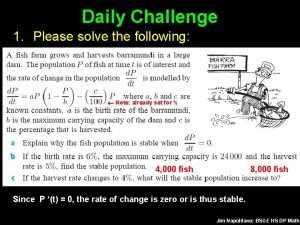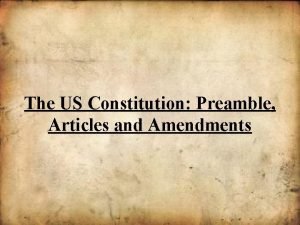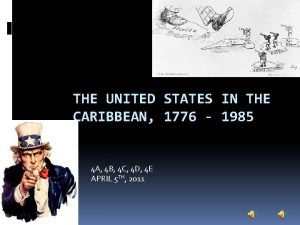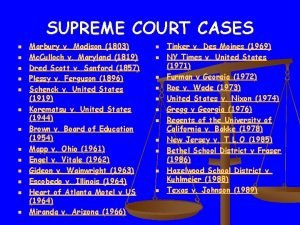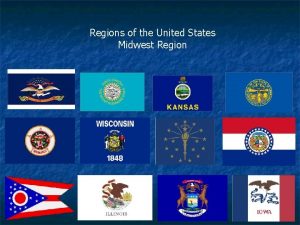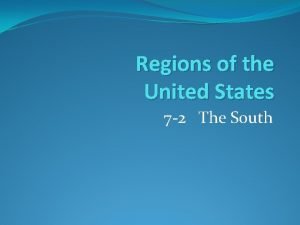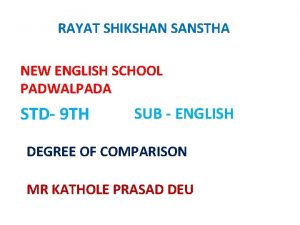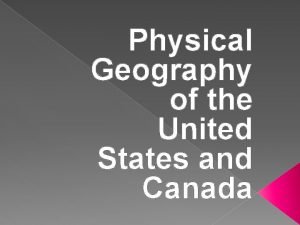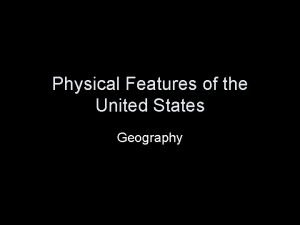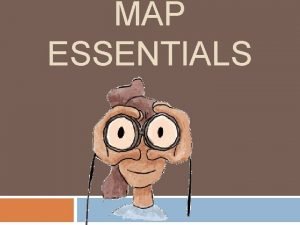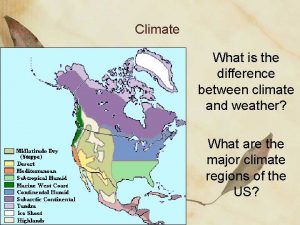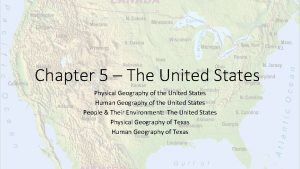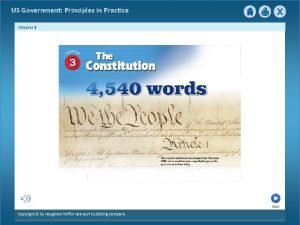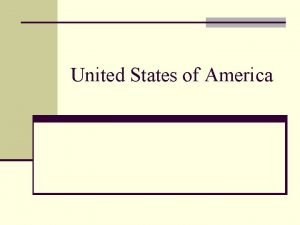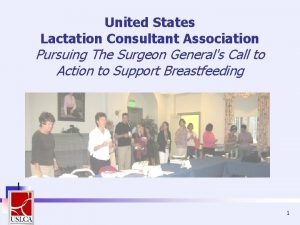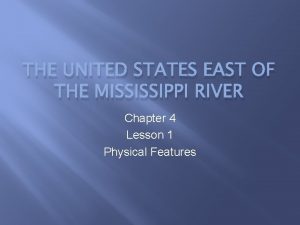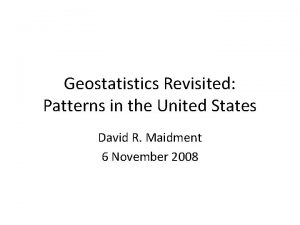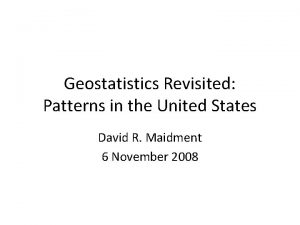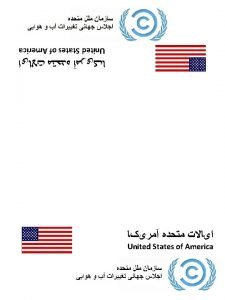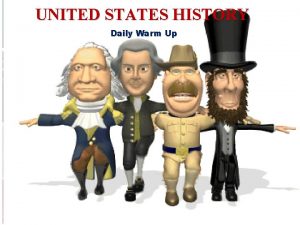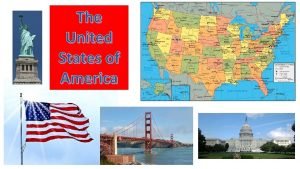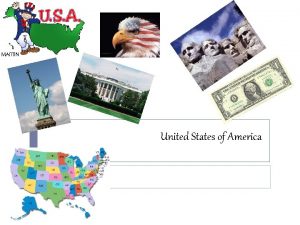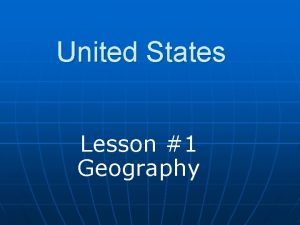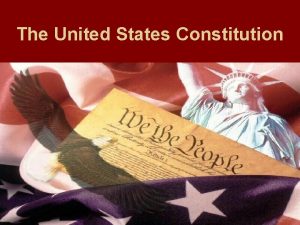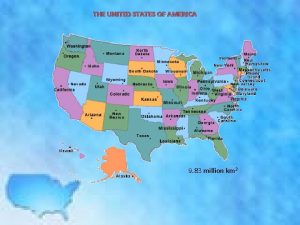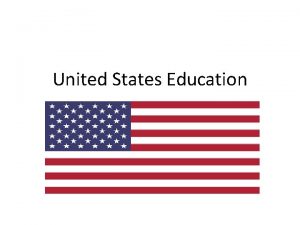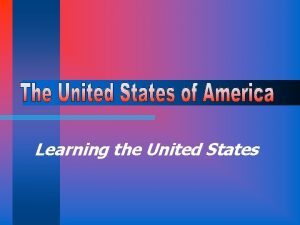Geostatistics Revisited Patterns in the United States David






































- Slides: 38

Geostatistics Revisited: Patterns in the United States David R. Maidment 6 November 2008

Election as Geostatistics: Location matters!!

Statistical sampling of voters Final Preelection Polls Election on (11/4/08)

Election “Population” Population size: 125, 225, 901 Spread – Obama: 53% to Mc. Cain: 46%

Election “Sample” (Stratified Random Sampling) National Survey of 1, 000 Likely Voters Sample size: 1000 Spread – Obama: 52% to Mc. Cain: 46% Sample: Population = 1000 : 120 million or 0. 00083%

Air Temperature: “Population” Nebraska

Air Temperature “Sample” (Mean annual values from Nebraska)

What are Statistics?

How do Geostatistics Differ from Statistics?

Random Fields: Probabilistic processes in space Voters: A finite population of spatially discrete objects Air Temperature: An infinite population which forms a spatial continuum

Air Temperature on an X-Y plane Northing, Y Easting, X

Geostatistics: Orientation matters! Temperature vs Northing, Y Temperature versus Easting, X 14. 00 12. 00 10. 00 8. 00 6. 00 4. 00 2. 00 0 200000 400000 600000 800000 1000000 0. 00 4278684 4378684 4478684 4578684 4678684 4778684 4878684

Temperature and Elevation 14. 00 Temperature vs Elevation 12. 00 10. 00 8. 00 6. 00 4. 00 2. 00 0 1000 2000 3000 4000 5000 6000 7000 Contrary trend to normal, where temperature decreases with elevation

Histogram of Air Temperature Degrees Centigrade * 10 -1

Normal Q-Q Plot s Centigrade * 10 -1 Standard Normal Variate, z

Normal Q-Q Plotting posn = (i-0. 5)/n, i=1 is lowest value and i= n is highest value x z

Trend Analysis

Semivariogram and Covariance

Semivariogram Dist = 4. 75 x 105 m

Detrending with an first order (linear) surface

Trend removal Semivariogram with no trend removal Long memory data Semivariogram with linear trend removal Short memory data

Mean, Standard Deviation and Standard Error of Estimate Air Temperature data in Nebraska (215 sites) Mean = 6. 96 °C Standard Deviation = 2. 07 °C Standard Error of Mean = 0. 47 °C

Prediction and Standard Error Maps

Estimating Water Use in the United States http: //www. nap. edu/catalog. php? record_id=10484

National Water Use Estimation All variables defined for state i in year t TW = total water use PS = public water supply DM = domestic use CM = commercial use IR = irrigation use LS = livestock use IN = industrial use MN = mining use TE = thermoelectric use

State Water Use Databases Survey undertaken with the assistance of USGS water use specialists • Category 1 (10 states) – Arkansas, Delaware, Hawaii, Indiana, Kansas, Louisiana, Massachusetts, New Jersey, New Hampshire, Vermont • Category 2 (12 states) – Alabama, Illinois, Maryland, Minnesota, Mississippi, New Mexico, North Dakota, Ohio, Oklahoma, Oregon, Utah, Virginia • Category 3 (28 states + PR) – Alaska, Arizona, California, Colorado, Connecticut, Florida, Georgia, Idaho, Iowa, Kentucky, Maine, Michigan, Missouri, Montana, Nebraska, Nevada, New York, North Carolina, Pennsylvania, Puerto Rico, Rhode Island, South Carolina, South Dakota, Tennessee, Texas, Washington, West Virginia, Wisconsin, Wyoming Category 1 2 3

Water Use Estimation • Direct Estimation: sample n and extrapolate to population of size N • Indirect Estimation: use regression or a water use coefficient model to get water use in each state

Trends in Water Use in the US Solley et al. , 1998

Total Water Use Nuclear power plant in Pope County (1/12 of all water use in the State)

Arkansas Site-Specific Water-Use Database ~50, 000 points with monthly water withdrawal estimates

Surface and Groundwater Points Surface water: 5, 600 points Groundwater: 39, 100 points Data are reported to AWSCC in acre-ft per month or year Data are reported to USGS national summary in MGD

Arkansas Aquifers Ozark Plateaus Edwards-Trinity Mississippi River Valley Alluvium Mississippi Embayment

Withdrawals from the Mississippi Alluvium 33, 700 wells (86%) out of 39, 100 total draw from the Mississippi Alluvium

Stratified Random Sampling • VT = variance of total water use • Nh = total number of sites in stratum h, • nh = sampled sites in stratum h, • n = total number of samples • and sh 2 = variance of water use at a site in stratum h h=L s. L 2 Domestic Comm. Industrial h=2 s 22 Irrigation h=1 s 12 PWS

Number of Samples Required Arkansas, irrigation from groundwater Total use = 5, 492, 730 MG % Standard Error No. of Samples 10% 111 5% 445 1% 8600 Random sampling: Desired standard error = 549, 273 MG requires 111 samples

A Sampling Scheme (for 10% standard error in total water use) nh Nh n= Power uses have complete inventory, others are randomly sampled

Summary of Recommendations • Elevate the NWUIP to a water-use science program, emphasizing statistical estimation of water use and the determinants and impacts of water use. • Systematically compare water-use estimation methods to identify the techniques best suited to the requirements and limitations of the NWUIP. Determine the standard error for every water-use estimate. • (Move from an inventory model to a statistical model to produce national estimates. )

Summary of Recommendations • Systematically integrate datasets, including those maintained by other federal and state agencies, into datasets already maintained by the NWUIP. • Focus on the scientific integration of water use, water flow, and water quality to expand knowledge and generate policy-relevant information about human impacts on both water and ecological resources • Seek support from Congress for dedicated funding of a national component water-use science program to supplement the existing funding in the Coop Program This is now funded and is called the “Water for America” program
 Straight line motion revisited homework
Straight line motion revisited homework Zhuoyue zhao
Zhuoyue zhao Was the united states on the axis powers or allied powers?
Was the united states on the axis powers or allied powers? Unit 2 the united states and canada
Unit 2 the united states and canada Sectionalism map of the united states
Sectionalism map of the united states Us pro soccer teams
Us pro soccer teams United states v. nixon significance
United states v. nixon significance United states student association
United states student association The united states ought to provide a universal basic income
The united states ought to provide a universal basic income Us constitution preamble
Us constitution preamble The united states in the caribbean 1776 to 1985
The united states in the caribbean 1776 to 1985 Products of the southeast
Products of the southeast Expansion of the united states of america 1607 to 1853 map
Expansion of the united states of america 1607 to 1853 map Why did truman believe greece needed aid
Why did truman believe greece needed aid Original 13 states date acquired
Original 13 states date acquired Who wrote awake united states
Who wrote awake united states Heart of atlanta motel v. united states
Heart of atlanta motel v. united states Why did the united states invade cuba in 1898?
Why did the united states invade cuba in 1898? Chapter 6 lesson 2 guided reading answers
Chapter 6 lesson 2 guided reading answers Midwestern region of the united states
Midwestern region of the united states 7 regions of the united states
7 regions of the united states The united states is the greatest buyer positive degree
The united states is the greatest buyer positive degree United states and canada physical map
United states and canada physical map Physical geography usa
Physical geography usa United states map with longitude and latitude lines
United states map with longitude and latitude lines 50 nifty united states
50 nifty united states Chapter 2 free enterprise in the united states
Chapter 2 free enterprise in the united states North central america
North central america The history of clowns
The history of clowns Subtropical united states
Subtropical united states What are the social classes in the united states
What are the social classes in the united states Physical geography of the united states
Physical geography of the united states Ibn-tamas v. united states
Ibn-tamas v. united states Themes in when mr pirzada came to dine
Themes in when mr pirzada came to dine United states government: principles in practice solutions
United states government: principles in practice solutions Geographical position usa
Geographical position usa United states lactation consultant association
United states lactation consultant association What is the highest court in the united states? *
What is the highest court in the united states? * States east of the mississippi
States east of the mississippi
